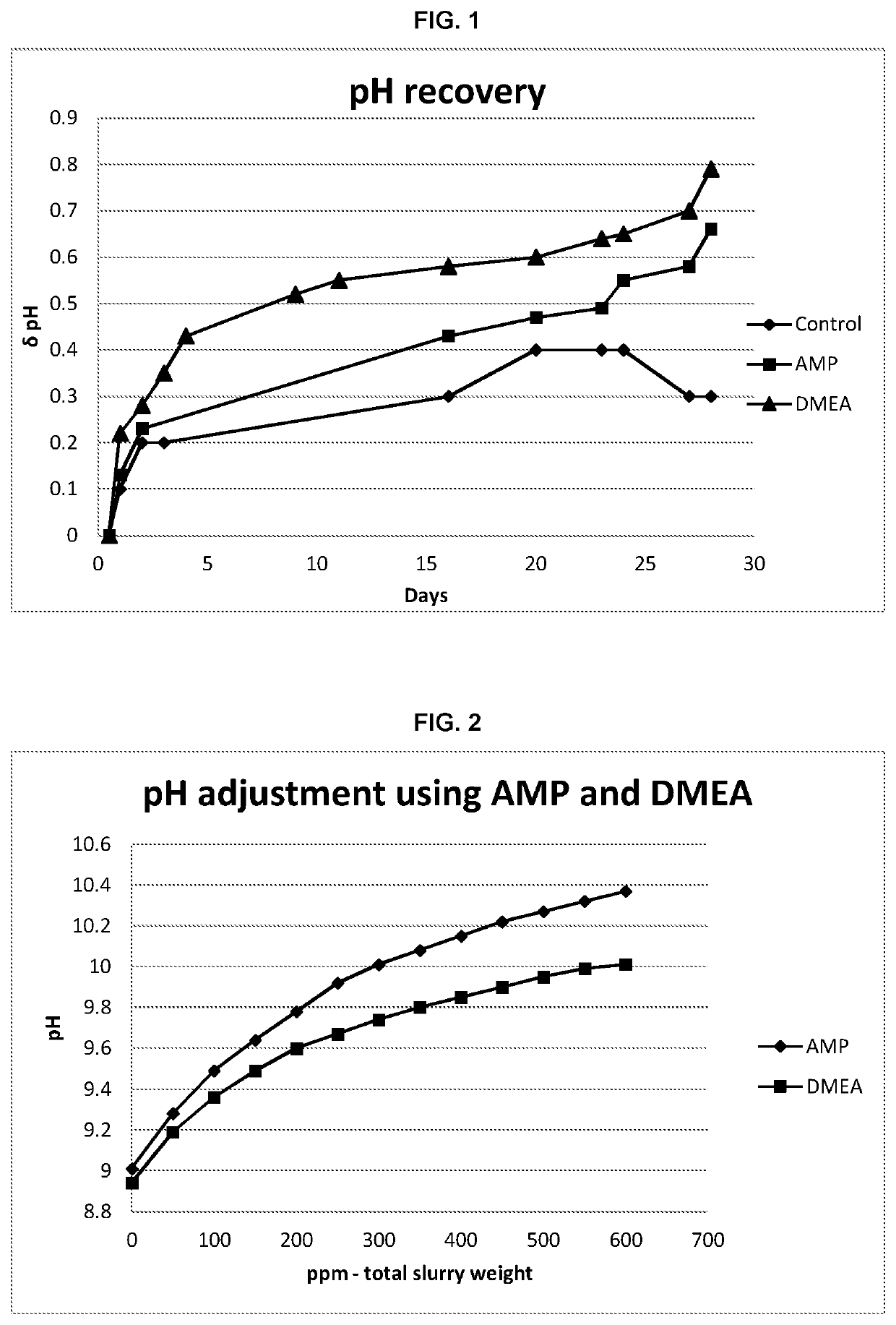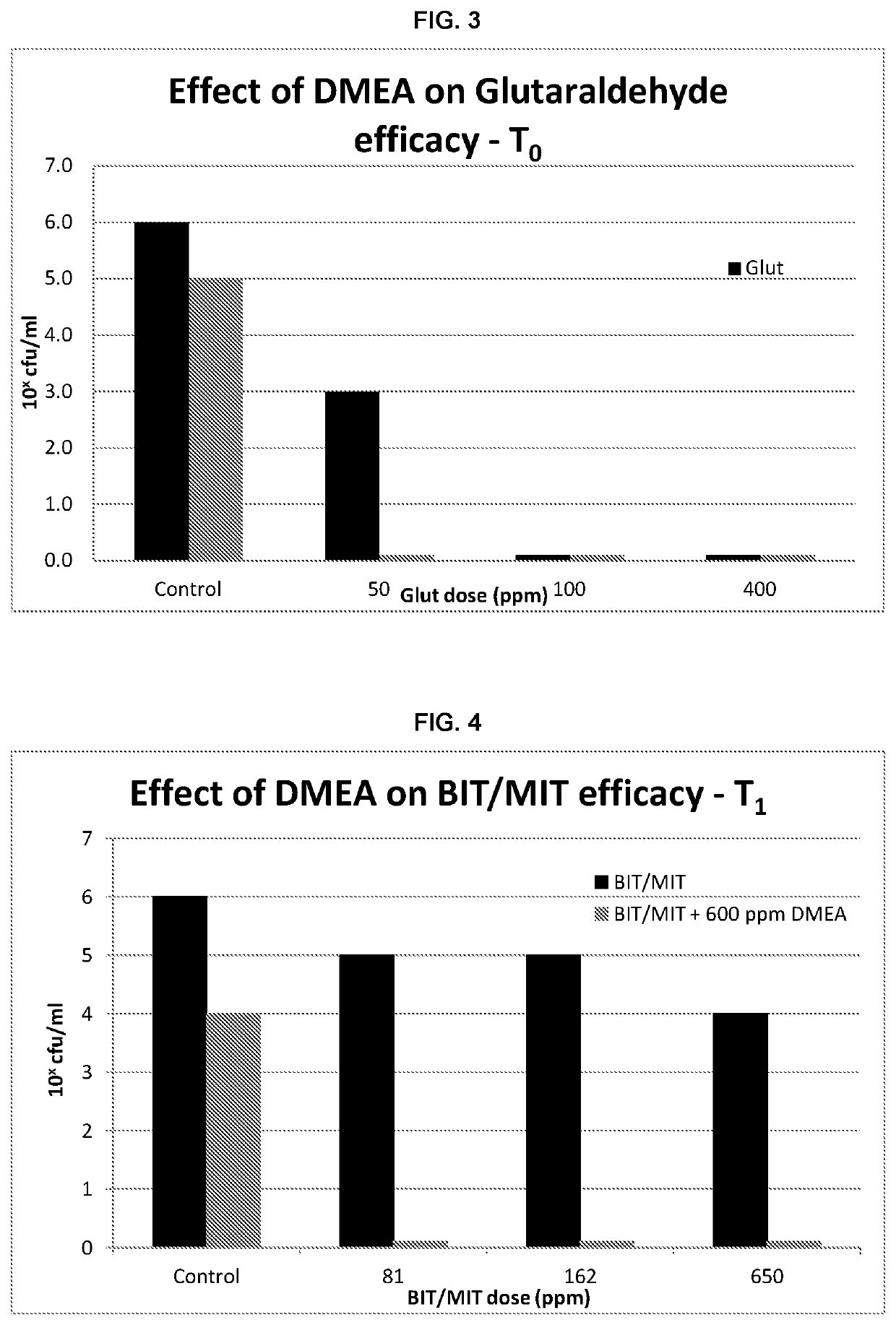Aqueous suspension of inorganic particulate material
a technology of inorganic particulate material and aqueous suspension, which is applied in the field of aqueous suspension, can solve the problems of affecting the suitability of the aqueous suspension to be sold for an intended purpose, affecting the properties and affecting the suitability of the aqueous suspension to be sold, so as to reduce the rate of ph decrease and prevent ph decrease
- Summary
- Abstract
- Description
- Claims
- Application Information
AI Technical Summary
Benefits of technology
Problems solved by technology
Method used
Image
Examples
example 1
[0136]1 kg samples of a calcium carbonate slurry having 78 wt % solids and 60% of particles less than 2 μm in size (measured using a micrometrics sedigraph) were adjusted to pH at room temperature using 2-amino-2-methyl-1-propanol (AMP) or dimethylethanolamine (DMEA). The control sample was adjusted to pH 10 using dilute sodium hydroxide solution. The solids content of the samples was adjusted using deionised water.
[0137]The pH of each slurry was lowered to pH 8 by aspirating the sample with carbon dioxide (CO2) enriched air (2%) using a flow rate of 5 mL / min. When pH 8 had been reached, aspiration of the sample was stopped.
[0138]Recovery of the sample pH was then monitored and recorded over subsequent days using the Mettler Toledo FE20 pH meter as described above in the detailed description. The results are shown in Table 1 and FIG. 1.
[0139]
TABLE 1pH ofpH ofDaypH ofsamplesamplemeasurementControlcomprisingcomprisingtakensampleδ pHAMPδ pHDMEAδ pH09.209.5010.000.58.000.08.000.008.000....
example 2
[0142]50 mg / kg aliquots of either AMP or DMEA were sequentially added to 250 g calcium carbonate slurry samples having 78 wt % solids and 60% of particles less than 2 μm in size (measured using a micrometrics sedigraph). In this context, 50 mg / kg means that 50 mg of AMP or DMEA was added per kg of dry inorganic particulate material in the aqueous suspension. The pH of the samples was measured after stirring immediately after each 50 mg / kg addition. The results are shown in Table 2 and FIG. 2.
[0143]
TABLE 2SamplesTotal mg / kg ofcomprising AMPSamples comprising DMEAchemical addedpH of sampleδ pHpH of sampleδ pH09.018.94509.280.279.190.251009.490.219.360.171509.640.159.490.132009.780.149.600.112509.920.149.670.0730010.010.099.740.0735010.080.079.800.0640010.150.079.850.0545010.220.079.900.0550010.270.059.950.0555010.320.059.990.0460010.370.0510.010.02
[0144]The results show that a similar pH increase was seen with both AMP and DMEA.
example 3
[0145]Samples of a contaminated calcium carbonate slurry having 78 wt % solids and 60% of particles less than 2 μm in size (measured using a micrometrics sedigraph) comprising various amounts of the biocide glutaraldehyde, and DMEA were prepared. The total viable count (cfu / ml) of each sample was measured after 0, 1 and 7 days by the method described above in the detailed description. The results are shown in Table 3 and FIG. 3.
[0146]
TABLE 3Total Viable Count (cfu / ml) ofChemicalsamples as 10xAddition (ppm)×(0 days×(1 day×(7 daysGlutar-afterafterafterSamplealdehydeDMEApreparation)preparation)preparation)10066620600540.1350030.10.14506000.10.10.1510000.10.10.161006000.10.10.1740000.10.10.184006000.10.10.1
[0147]It was surprisingly found that samples comprising DMEA in combination with a 50 ppm dose of glutaraldehyde have a lower total viable count after 0 days in comparison with a sample comprising a 50 ppm dose of glutaraldehyde but no DMEA. The use of DMEA in combination with a 50, 1...
PUM
| Property | Measurement | Unit |
|---|---|---|
| initial viscosity | aaaaa | aaaaa |
| time | aaaaa | aaaaa |
| time | aaaaa | aaaaa |
Abstract
Description
Claims
Application Information
 Login to View More
Login to View More - R&D
- Intellectual Property
- Life Sciences
- Materials
- Tech Scout
- Unparalleled Data Quality
- Higher Quality Content
- 60% Fewer Hallucinations
Browse by: Latest US Patents, China's latest patents, Technical Efficacy Thesaurus, Application Domain, Technology Topic, Popular Technical Reports.
© 2025 PatSnap. All rights reserved.Legal|Privacy policy|Modern Slavery Act Transparency Statement|Sitemap|About US| Contact US: help@patsnap.com



